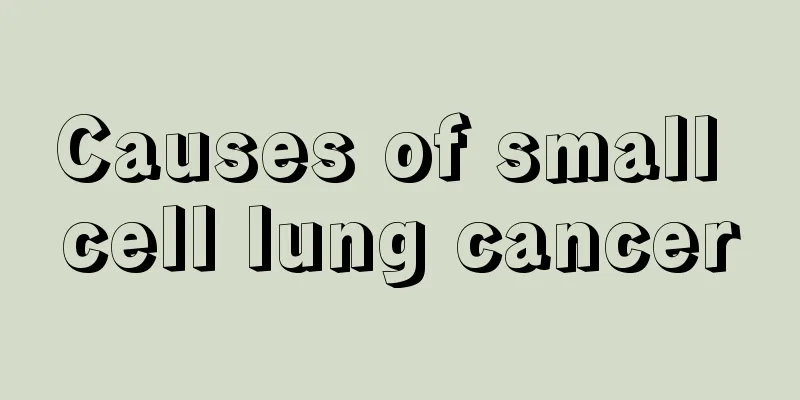Causes of small cell lung cancer

|
What is the cause of small cell lung cancer? Many people do not know what causes this disease. In fact, most lung diseases are caused by smoking, so timely treatment is necessary when they are discovered. Let's learn about the causes of small cell lung cancer! The disease is related to the following factors: 1) Smoking: It is generally recognized that smoking is an important risk factor for small cell lung cancer. The more you smoke, the longer you smoke, and the earlier you start smoking, the higher the lung cancer mortality rate. The risk of small cell lung cancer in smokers gradually decreases as the number of years of quitting increases. It takes 15 years of quitting to be close to that of non-smokers. Passive smoking can also easily cause small cell lung cancer. 2) Occupational carcinogens: Confirmed occupational carcinogens that cause human small cell lung cancer include asbestos, inorganic arsenic compounds, dichloromethyl ether, chromium and certain compounds, nickel smelting, radon and radon progeny, mustard, vinyl chloride, soot, tar and polycyclic aromatic hydrocarbons in petroleum, heating products of tobacco, etc. 3) Air pollution: Air pollution includes indoor micro-environment and outdoor macro-environment pollution. For example, passive smoking, fuel combustion and carcinogens produced during cooking. Car exhaust, industrial waste gas and road asphalt in cities all contain carcinogens, the main of which is benzopyrene. 4) Ionizing radiation: Large doses of ionizing radiation can cause small cell lung cancer. Different rays of radiation produce different effects. For example, Hiroshima in Japan released neutrons and gravitational rays, while Nagasaki only released gravitational rays. The former has a higher risk of small cell lung cancer than the latter. 5) Diet and nutrition: Animal experiments have shown that vitamin A and its derivative beta-carotene can inhibit tumors induced by chemical carcinogens. 6) Others: Viral infection, fungal toxins (Aspergillus flavus), tuberculosis scars, low immune function, endocrine disorders and family inheritance may also play a certain combined role in the occurrence of small cell lung cancer. What are the preventive measures: 1. Quit smoking. The earlier you quit smoking, the lower the risk of lung cancer. At the same time, avoid passive smoking and stay away from smoking environments. Smokers should also consider others, take the initiative to control themselves, and not smoke in public places. 2. Stay away from radioactive materials. When working in a toxic and harmful environment, you should take protective measures to reduce occupational hazards; avoid indoor smoke and decoration pollution, and pay attention to good ventilation in the kitchen; in addition, stay away from radioactive materials. 3. Balanced nutrition. Vegetables and fruits are rich in nutrients such as carotene, vitamin C, vitamin E, folic acid, etc., which are beneficial to lung health, so you should eat more of them; garlic, seafood, grains, mushrooms, sesame, eggs, etc. are rich in selenium, which has anti-cancer and anti-cancer effects, so you should eat more of them. 4. Maintain a regular life. Be in a good mood, combine work and rest, and keep exercising to increase your ability to prevent and resist diseases. 5. Perform lung examinations every year. To detect small cell lung cancer early, we need to raise awareness and strengthen lung examinations, especially those who have smoked for more than 20 years, smoke more than 20 cigarettes a day on average, and those over 40 years old with a long history of smoking, a family history of cancer, or work in toxic and harmful environments. They should go to a regular hospital for a CT scan every year. This is an effective way to detect small cell lung cancer early. For those who have irritating dry cough, blood in sputum, chest pain, low fever, and repeated lung infections, if they do not heal after active anti-inflammatory treatment, they should pay attention and go to the hospital for examination in time. |
<<: What are the causes of small cell lung cancer
>>: What are the symptoms and characteristics of small cell lung cancer
Recommend
How to fix ugly permed hair
Many people have had the experience of perming th...
What are the ways to prevent breast cancer
In recent years, breast cancer has become one of ...
The difference between rheumatism and bone cancer
A 15-year-old girl had a bone tumor (commonly kno...
Use of citric acid and baking soda after reaction
Citric acid is an acidic substance. When citric a...
The difference between external hemorrhoids and internal hemorrhoids, just look at the following to know
There is a difference between external hemorrhoid...
Can late-stage ovarian tumors be cured?
At present, there are actually very good methods ...
What are the benefits of garlic soaked in vinegar
Garlic soaked in vinegar has good health benefits...
What nutritional medicine is used for advanced rectal cancer
There are still some controversies about nutritio...
What are the dangers of spoiling children?
When it comes to their children's education, ...
What is the control range of TG in hemisection of thyroid cancer
The range of TSH (thyroid-stimulating hormone) co...
What should I do if my facial expression is stiff
I believe that many people are prone to having st...
What is the difference between cuttlefish and squid?
Everyone is familiar with squid. Squid is rich in...
Can cervical precancerous lesions be cured? How to treat cervical precancerous lesions?
Most cervical precancerous lesions can be cured a...
Pay attention to dietary care after colon cancer surgery
When the colon has a tumor, the defecation functi...
Is nasopharyngeal cancer contagious?
Laryngeal cancer is not contagious because it doe...









